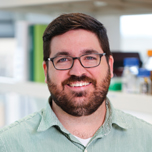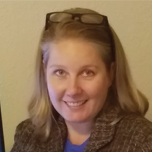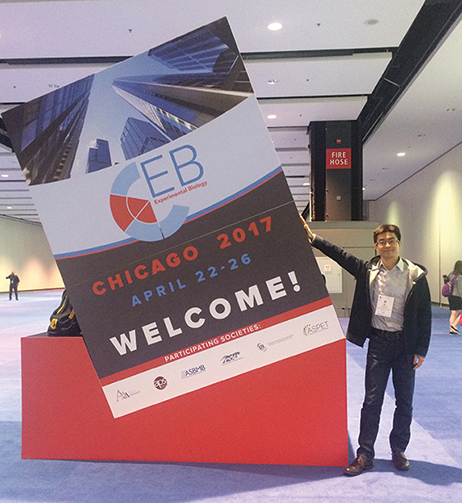15 minutes of fame
In making his very first scientific presentation at the 2017 ֲי¶¹´«ֳ½ֹ«ַיֶ¬ and ֲי¶¹´«ֳ½ֹ«ַיֶ¬ Biology Annual Meeting, Matthew Wickersham also made connections that helped with his research. “People came up to me after the meeting,” he said, “and we’ve been in contact about potential collaborations.”
Wickersham, a research technician in pediatrics at Columbia University, shared his research on metabolic stress driving keratinocyte defenses against S. aureus as one of 235 scientists — from undergraduates to senior investigators — who took part in the meeting’s Spotlight Sessions, a new opportunity to highlight recent scientific findings.
To find out more about the presenters’ experience in these first Spotlight Sessions, ASBMB Today sent a questionnaire to all the participants. We share some highlights of the responses here. Maybe you’ll feel inspired to submit your abstract by the Dec. 7 deadline so you can share your science in San Diego next April.
 James Miller
James Miller
 Evan Cornett
Evan Cornett
 Andrew Bonham
Andrew Bonham
 Ditlev Brodersen
Ditlev Brodersen
 Melvin Noe-Gonzaelz
Melvin Noe-Gonzaelz
 Gareth Langley
Gareth Langley
 Sharon Rozovsky
Sharon Rozovsky
 Christina Bourne
Christina Bourne
 Ray Blind
Ray Blind
 Morgan Milton
Morgan Milton
Wickersham was not the only presenter to make valuable connections during the sessions, which ran over three afternoons in multiple rooms during the Chicago meeting. James Miller, a graduate student in biochemistry at the Medical College of Wisconsin, gave a talk on glycolipid storage and phenotypes in a new rat model of Fabry disease and met a graduate student who was doing similar research. “He recommended that I use a certain reagent to stain my rat tissues for histological analysis,” Miller said.
After making his presentation on annotating the lysine methylome, Evan Cornett, a postdoctoral fellow in the center for epigenetics at the Van Andel Research Institute, made several productive connections. “I connected with another researcher studying lysine methyltransferases, and we have now started a collaboration to screen the enzymes they are studying on our platform,” he said. “I also connected with another researcher who had some reagents and experiment ideas to help determine what the methylation on one of the new methylation targets we discovered is doing to regulate that protein."
Emily Roncase, a fourth-year graduate student in molecular and experimental medicine at The Scripps Research Institute, gained new insight after her presentation on substrate selectivity of clostripainlike proteases secreted from commensal gut bacteria. “I met another graduate student that works in enzymology who was able to give me great insights into other assays I can perform to determine how these proteases are being activated,” she said.
Andrew Bonham, an associate professor of chemistry at the Metropolitan State University of Denver, made a productive connection after his talk on algorithmic techniques for designing electrochemical DNA biosensors. “My presentation was noticed by a start-up biotech company that is now collaborating with me,” he said.
The Spotlight Sessions scientists are at all stages of their careers. Not every presenter who responded to the questionnaire wanted to share their age, but those who did ranged from 23 to 51 years old, with almost half under the age of 30. Participants came from all over the U.S. and as far away as Australia and Japan.
The majority of those who answered the questionnaire, 86 percent, had presented their research previously, but that didn’t stop them from preparing and honing their delivery for the new Spotlight Session format, which required that they condense their work into 15 minutes (a 12-minute talk and a three-minute Q and A) for an audience that was not as “intimately familiar with all the nuances and details as my lab mates are,” as Cornett described it.
“I made slides and went through them in a natural pace two to three times, thinking about what I would say,” said Ditlev Brodersen, an associate professor in the department of ֲי¶¹´«ֳ½ֹ«ַיֶ¬ Biology and Genetics at Aarhus University, who spoke about how discrete structural dynamics of pseudo-palindromic motifs control DNA binding of bacterial toxin-antitoxin complexes.Melvin Noe–Gonzalez, a fifth-year graduate student at the Stowers Institute for Medical Research, said he prepared a script of everything he was going to say in his talk on the mechanism of co-transcriptional RNA capping — “not for memorization, though, but for remembering the key points I needed to get across … It was challenging trying to find a shorter way to present something or decide what data had to go,” he said, but “not going over shows that you respect everyone’s time.”
Gareth Langley, a fourth-year Ph.D. student in chemistry at the University of Oxford, agreed on the importance of not running over his allotted time. He practiced with his research group to fix his timing and said the most memorable moment of his talk on demethylases was “seeing the clock hit zero (for the presentation section) just as I was about to hit my acknowledgements slide.”
A number of the presenters said they practiced their talks in front of their friends, family and lab colleagues. Miller turned some heads when he was caught “doing a quick run-through in a quieter hallway of the McCormick Place a few hours before my presentation,” he said. “Passers-by gave me perplexed looks when they saw me talking to myself.”
In addition to the valuable experience of making a presentation, a number of the Spotlight Session participants noted how much they valued hearing what their fellow scientists had to share. Sharon Rozovsky, an associate professor in chemistry and biochemistry at the University of Delaware who spoke on the intrinsically disordered membrane enzymes selenoprotein S and selenoprotein K, said she had discussions with all the “excellent speakers” in her session. “It was a great panel,” she said.
Christina Bourne, an assistant professor in chemistry and biochemistry at the University of Oklahoma who presented on toxin-antitoxin modules, said she enjoyed “meeting the other presenters and going out for a drink after the session — it was a great informal way to meet a few big names in the field, as well as some up-and-coming investigators.”
At his presentation on lipids, Ray Blind, an assistant professor of medicine, biochemistry and pharmacology at Vanderbilt University School of Medicine, said he “met some good PhD students that I am trying to recruit as postdocs to my lab.”
Morgan Milton, a postdoc in discovery sciences at RTI International, said she used what s had learned in the ASBMB Art of Science Communication online course (see related story on page 34) to build her presentation on inhibition and dispersion of biofilms. “I began by focusing on what story I wanted to tell and thinking about what the ASBMB audience would be interested in learning,” she said. “It was challenging to pick through all of our data to piece together a cohesive story; interesting things had to be cut simply because there was just so much to tell. I would practice almost daily, fine-tuning my message and the delivery and getting feedback from co-workers.” Milton said it was memorable to watch her presentation morph from the original draft to its final version. “Sometimes you fall in love with a particular slide or data set but in the end have to cut it because it just doesn’t fit in with the rest of the presentation.”
In making the presentation, she said she learned that “How you say something is just as important as why you want to say (it). Finding a clear way to present information to your audience is vital for a successful presentation.”
 Di Zhang, a University of Chicago postdoc, poses beside the annual meeting sign. Zhang gave his first scientific talk during the 2017 Spotlight Sessions.photo courtesy of Di Zhang
Di Zhang, a University of Chicago postdoc, poses beside the annual meeting sign. Zhang gave his first scientific talk during the 2017 Spotlight Sessions.photo courtesy of Di Zhang
The Spotlight Sessions offered a new opportunity to share science and make connections at the ASBMB annual meeting. For some, it was an experience not to be forgotten. Di Zhang, a postdoc in the University of Chicago’s department for cancer research who was making his first research presentation on metabolic regulation of gene expression by histone b-hydroxybutyrylation, said, “It would be great if the presentations can be recorded, since it would be a memory for the speakers, especially for beginners like me.”
Put your science in the spotlight
The annual meeting of the ֲי¶¹´«ֳ½ֹ«ַיֶ¬ and ֲי¶¹´«ֳ½ֹ«ַיֶ¬ Biology can seem like the Grammy Awards for biological sciences. It’s hard not to be dazzled by the roster of award winners and symposium speakers, many of whose names appear in textbooks conducting the classical experiments.
At the Grammys, however, a true music lover might miss the music festival experience of an event such as Austin City Limits, where you can rendezvous with the music you grew up with or meet the newest bands — or even be one of the performers who take the stage. Well, you don’t have to make the difficult choice at the ASBMB annual meeting, because we want you to enjoy the best of both worlds. While maintaining the high profile of plenary and symposium speakers, we have added a platform called Spotlight Sessions to the annual meeting program for new ideas, fresh discoveries and rising stars.
The Spotlight Sessions at the 2018 ASBMB Annual Meeting in San Diego will include more than 200 scientific talks — and you could be one of the presenters. These talks will be selected from abstracts submitted by meeting attendees who opt to be considered. The criterion for selection is simple: Is the science exciting?
The platform is designed to create an optimal experience for speakers and audience. The sessions are held during the afternoon prime time in our full-day programs with no competing seminars scheduled. A cornucopia of scientific themes are covered, with concurrent sessions in multiple meeting rooms to guarantee your scientific curiosity is satisfied.
Each session consists of five 15-minute talks, each with three minutes for Q and A. After a 15-minute break, another Spotlight Session on a related topic is held in the same room so the audience doesn’t need to relocate to search for their favorite scientific topics.
The Spotlight Sessions were introduced at the 2017 annual meeting in Chicago. Out of 1,604 voluntary abstracts submitted by the deadline, the authors of 752 were interested in making an oral presentation. A panel of organizers consisting mostly of junior faculties selected 235 talks for the 42 spotlight sessions over three afternoons (a selection rate of 31 percent). More than half the speakers were trainees. For many, especially the 139 who were postdocs and graduate students, this was their first talk in a national forum. Of those who held faculty positions, 77 percent were early-stage investigators with assistant or associate professorship.
Do you want your colleagues to be inspired by your passion for your project at next year’s annual meeting in San Diego? Due to the well-received Spotlight Sessions in Chicago, we plan to expand the session topics in 2018. To be considered for a short talk, submit your abstract to an ASBMB topic category, those with a 2,000-series topic number, by the Dec. 7 deadline.
 Yan Jessie Zhang is an associate professor in department of molecular biosciences at University of Texas, Austin, and a member of the ASBMB Meetings Committee.
Yan Jessie Zhang is an associate professor in department of molecular biosciences at University of Texas, Austin, and a member of the ASBMB Meetings Committee.We look forward to hearing your exciting story.
 Comfort Dorn is the managing editor of ASBMB Today.
Comfort Dorn is the managing editor of ASBMB Today.Enjoy reading ASBMB Today?
Become a member to receive the print edition four times a year and the digital edition weekly.
Learn moreFeatured jobs
from the
Get the latest from ASBMB Today
Enter your email address, and weג€™ll send you a weekly email with recent articles, interviews and more.
Latest in Careers
Careers highlights or most popular articles

Upcoming opportunities
Friendly reminder: Book a recruiter table at ASBMB's career and education fair by Nov. 30 to secure early-bird pricing! Just added: Applications are being accepted for a post-bac at Dartmouth Cancer Center.

Upcoming opportunities
Just added: Register for ASBMB's virtual session on thriving in challenging academic or work environments.

Who decides when a grad student graduates?
Ph.D. programs often donג€™t have a set timeline. Students continue with their research until their thesis is done, which is where variability comes into play.

Upcoming opportunities
Submit an abstract for ASBMB's meeting on ferroptosis!

Join the pioneers of ferroptosis at cell death conference
Meet Brent Stockwell, Xuejun Jiang and Jin Ye ג€” the co-chairs of the ASBMBג€™s 2025 meeting on metabolic cross talk and biochemical homeostasis research.

A brief history of the performance review
Performance reviews are a widely accepted practice across all industries ג€” including pharma and biotech. Where did the practice come from, and why do companies continue to require them?

